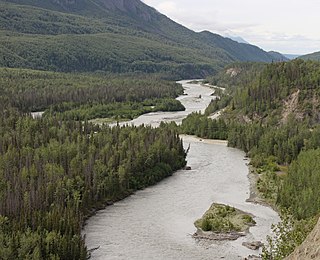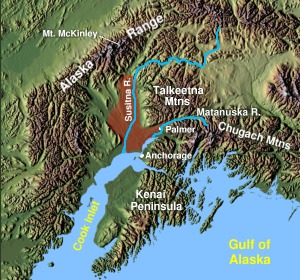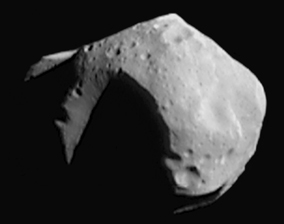
Southcentral Alaska is the portion of the U.S. state of Alaska consisting of the shorelines and uplands of the central Gulf of Alaska. Most of the population of the state lives in this region, concentrated in and around the city of Anchorage.

Matanuska-Susitna Borough is a borough located in the U.S. state of Alaska.

Palmer is a city in and the borough seat of the Matanuska-Susitna Borough in the U.S. state of Alaska. It is part of the Anchorage Metropolitan Statistical Area. As of the 2010 census, the population of the city is 5,937.

The Matanuska River is a 75-mile (121 km) long stream in Southcentral Alaska, United States. The river drains a broad valley south of the Alaska Range eponymously known as the Matanuska Valley.
The Glenn Highway is a highway in the U.S. state of Alaska, extending 179 miles (288 km) from Anchorage near Merrill Field to Glennallen on the Richardson Highway. The Tok Cut-Off is often considered part of the Glenn Highway, for a total length of 328 miles (528 km).
Matanuska–Susitna College in Palmer, Alaska, north of Anchorage, is part of the University of Alaska Anchorage system. The college began in 1958 as Palmer Community College, changing its name in 1963 to correspond to the Matanuska-Susitna Borough where it is located. It is commonly called Mat-Su College. Total enrollment is about 1,650. Talis Colberg was appointed as the fourth Director of the College in 2002.

Matanuska Glacier is a valley glacier in the US state of Alaska. At 27 miles (43 km) long by 4 miles (6.4 km) wide, it is the largest glacier accessible by car in the United States. Its terminus feeds the Matanuska River. It lies near the Glenn Highway about 100 miles (160 km) north-east of Anchorage. Matanuska Glacier flows about 1 foot (30 cm) per day. Due to ablation of the lower glacier, as of 2007, the location of the glacier terminus changed little over the previous three decades.

M/V Malaspina, colloquially known as the Mal, is a mainline ROPAX ferry and the original Malaspina-class vessel for the Alaska Marine Highway System. Malaspina is named after the Malaspina Glacier, which, in turn, is named after Captain Don Alessandro Malaspina, Italian navigator and explorer who explored the northwest coast of North America in 1791. Malaspina is nearly identical to her sister ship, M/V Matanuska.

MV Matanuska, colloquially known as the Mat, is a mainline Malaspina-class ferry vessel for the Alaska Marine Highway System.

Pioneer Peak is a 6,398-foot (1,950 m) mountain in the Chugach Mountains in the U.S. state of Alaska. Located beside the Knik River just nine miles (14.5 km) south of Palmer and about six miles outside the Municipality of Anchorage limits, it is a prominent landmark in the Matanuska-Susitna Valley, as well as a popular hiking destination. The name was given in 1939 in honor of the pioneers of the Matanuska agricultural colony of the mid-1930s. The Pioneer Ridge Trail leads up the eastern shoulder, beginning below 200', it allows access to the South summit. The North summit, and true summit of Pioneer Peak does not have a trail, and advanced mountaineering techniques are required.
There are several lakes named Mud Lake within the U.S. state of Alaska.

Jalmar Martin "Jay" Kerttula is an American retired businessman, farmer, and politician in Alaska. A member of the Democratic Party, Kerttula is the longest-serving member of the Alaska Legislature, having served in the House from 1961 to 1963 and 1965 to 1973 and in the Senate from 1973 to 1995.

Dinglishna Hills is an unincorporated community in Matanuska-Susitna Borough, Alaska, USA. An Alaskan Bush community, it was created by State of Alaska Department of Natural Resources through land auctions and subsequent over-the-counter land sales, in between the big Susitna River and Alexander Creek, near its named landmark: Dinglishna Hill, and Mount Susitna.
Matanuska-Susitna Borough School District (MSBSD) is a school district based in the city of Palmer, Alaska. It serves 40 schools, which each enroll from 15 to 1300 students. The estimated sum of the total number of students attending schools in this district is 15,969. MSBSD is the second-largest school district in Alaska, with the largest district being Anchorage School District.

Wasilla is a city in Matanuska-Susitna Borough, United States and the sixth-largest city in Alaska. It is located on the northern point of Cook Inlet in the Matanuska-Susitna Valley of the southcentral part of the state. The city's population was 7,831 at the 2010 census, up from 5,469 in 2000. Estimates in 2016 put the population at roughly 9,748. Wasilla is the largest city in the borough and a part of the Anchorage metropolitan area, which had an estimated population of 396,142 in 2013.
The Matanuska Formation consists of more than 3 km (1.9 mi) of sedimentary strata exposed in the northern Chugach Mountains, Matanuska Valley, and southern Talkeetna Mountains of South-Central Alaska. The Matanuska Formation contains strata from Early Cretaceous (Albian) to Late Cretaceous (Maestrichtian). Parts of the formation contain abundant marine mollusks, foraminifera, and radiolaria. Fossils of non-marine plants are found in some beds. Fossils of two dinosaurs have been recovered from marine mudstones in the formation. The lower Matanuska Formation (MF) is several hundred meters thick and includes non-marine and marine sediments. Campanian-Maastrichtian graded sandstone, conglomerate, and mudstone comprise the upper 2000 meters of the Formation.

Matanuska-Susitna Valley is an area in Southcentral Alaska south of the Alaska Range about 35 miles (56 km) north of Anchorage, Alaska. It is known for the world record sized cabbages and other vegetables displayed annually in Palmer at the Alaska State Fair. It includes the valleys of the Matanuska, Knik, and Susitna Rivers. 11,000 of Mat-Su Valley residents commute to Anchorage for work . It is the fastest growing region in Alaska and includes the towns of Palmer, Wasilla, Big Lake, Houston, Willow and Talkeetna.

In 1935, the Federal Emergency Relief Administration created an experimental farming community known as the Matanuska Valley Colony as part of the New Deal resettlement plan. Situated in the Matanuska Valley, about 45 miles northeast of Anchorage, Alaska, the colony was settled by 203 families from Minnesota, Wisconsin and Michigan. The colony project cost about $5,000,000 and, after five years, over half of the original colonists had left the valley. By 1965, only 20 of the first families were still farming the valley.














